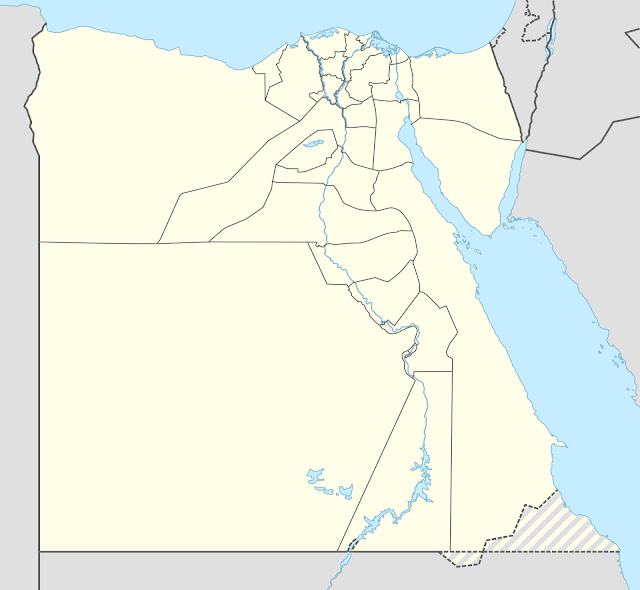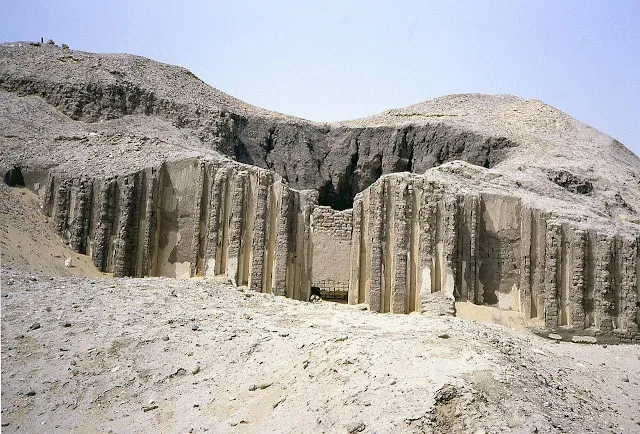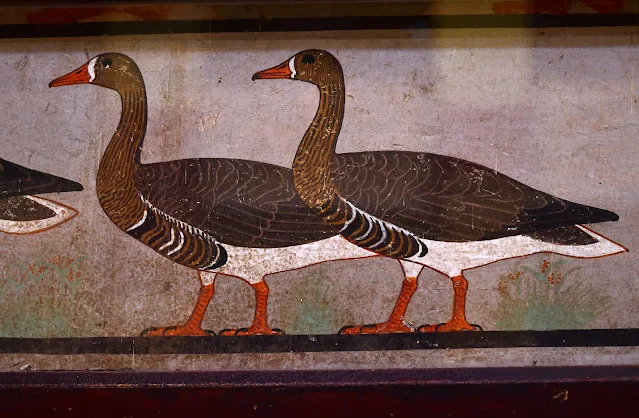Meidum Pyramid
Meidum, Maydum or Maidum is an archaeological site in Lower Egypt. It contains a large pyramid and several mudbrick mastabas. The pyramid was Egypt's first straight-sided one, but it partially collapsed in ancient times. The area is located around 72 kilometres south of modern Cairo.
The pyramid at Meidum is thought to be just the second pyramid built after Djoser's and may have been originally built for Huni, the last pharaoh of the Third Dynasty, and continued by Sneferu. Because of its unusual appearance, the pyramid is called el-heram el-kaddaab – (False Pyramid) in Egyptian Arabic.
The second extension turned the original step pyramid design into a true pyramid by filling in the steps with limestone encasing. While this approach is consistent with the design of the other true pyramids, Meidum was affected by construction errors. Firstly, the outer layer was founded on sand and not on rock, like the inner layers. Secondly, the inner step pyramids had been designed as the final stage. Thus, the outer surface was polished and the platforms of the steps were not horizontal, but fell off to the outside. This severely compromised the stability and is likely to have caused the collapse of the Meidum Pyramid in a downpour while the building was still under construction.
The Meidum Pyramid seems never to have been completed. Beginning with Sneferu and to the 12th Dynasty, all pyramids had a valley temple, which is missing at Meidum. The mortuary temple, which was found under the rubble at the base of the pyramid, apparently never was finished. Walls were only partly polished. Two stelas inside, usually bearing the names of the pharaoh, are missing inscriptions. The burial chamber inside the pyramid itself is uncompleted, with raw walls and wooden supports still in place which are usually removed after construction. Affiliated mastabas were never used or completed and none of the usual burials have been found. Finally, the first examinations of the Meidum Pyramid found everything below the surface of the rubble mound fully intact. Stones from the outer cover were stolen only after they were exposed by the excavations. This makes a catastrophic collapse more probable than a gradual one. The collapse of this pyramid during the reign of Sneferu is the likely reason for the change from 54 to 43 degrees of his second pyramid at Dahshur, the Bent Pyramid.
By the time it was investigated by Napoleon's Expedition in 1799, the Meidum Pyramid had its present three steps.
It is commonly assumed the pyramid still had five steps in the fifteenth century and was gradually falling further into ruin, because al-Maqrizi described it as looking like a five-stepped mountain, but Mendelssohn claimed this might be the result of a loose translation and al-Makrizi's words would more accurately translate into "five-storied mountain", a description which could even match the present state of the pyramid with four bands of different masonry at the base and a step on top.
Old Kingdom Hieroglyphs Fragment of a relief from Mastaba of prince Nefermaat, Meidum. Old Kingdom, 4th Dynasty, ca. 2613-2494 BC. Now in the Egyptian Museum, Cairo.
Prince Rahotep is an Old Kingdom, 4th Dynasty, Prince. He is probably a son of Pharaoh Sneferu and his first wife, although Zahi Hawass suggests his father was Huni. Rahotep's older brother was Nefermaat I, and his younger brother was Ranefer. Rahotep died when he was young, and so his half-brother Khufu became pharaoh after Sneferu’s death. Rahotep’s wife was Nofret. Her parents are not known. Nofret and Rahotep had three sons – Djedi, Itu and Neferkau – and three daughters – Mereret, Nedjemib and Sethtet. They are depicted in Rahotep’s tomb. This seated painted limestone statue of Rahotep sat belong side his wife Nofret was discovered by Albert Daninos, 21st December, 1871, near the pyramid of Meidum, Egypt.
Egypt - Itet in a scene originally from Nefermaat's tomb in Meidum. Now in the Oriental Institute in Chicago. Behind her on the bottom is a son named Ankherfenedjef. A son behind her to the top has not has a name preserved.
Check Availability Contact Us
For more information and inquiries on how to book one of the tours please contact us
For quicker communication contact via
Whatsapp:+2 01001918549 .


.png)











